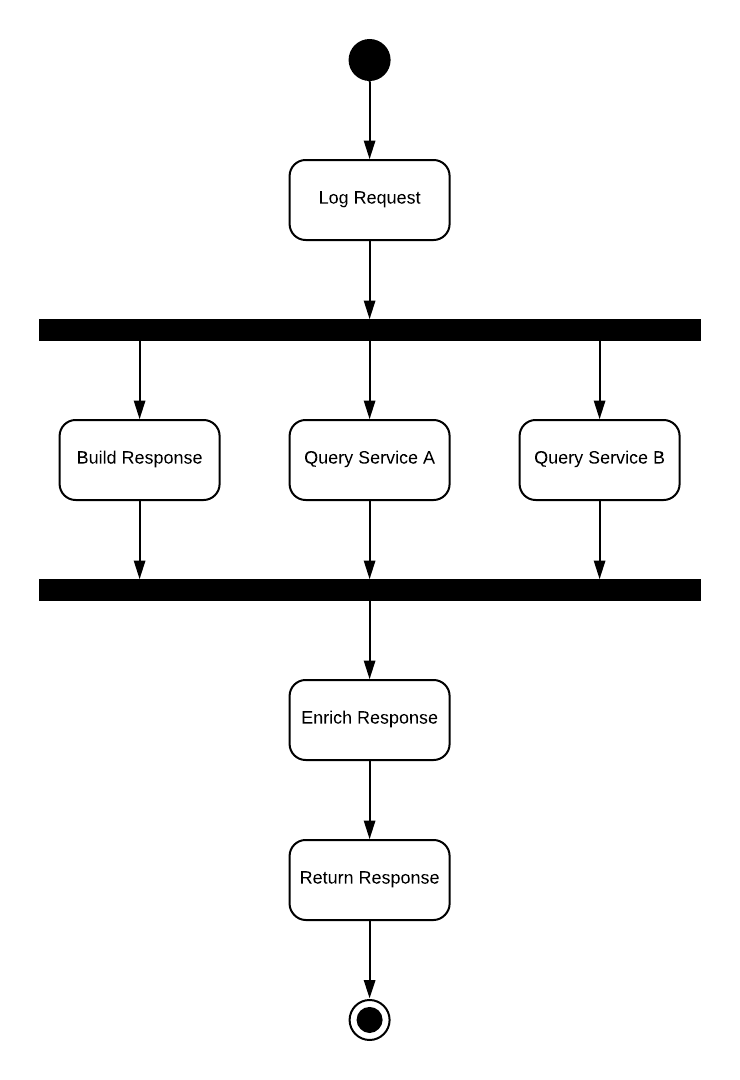Published: Nov 18, 2019 by martoc
Go supports multiple concurrency models, this diagram shows what actually want to implement, it parallelises 3 long running operations, generally these are calls to external services, for testing purposes these external call are mocked with different random delays (1-50 ms) and there is a restriction the whole service execution time cannot last more than 20ms.

In online advertising speed is everything and having all the information is
secondary, this proof of concept tries to check if concurrent operations can be
forked and joined and if any of these operations excess more than a cap value
the execution carries on and omits these slow operations. I’ve created 3
datasets to tests this, each data set contains 1000 requests and the latency
for the different operations, the requests-lowlatency.csv the operations
last between 1-3 ms, the next file is requests-highlatency.csv the latency in
this file is set between 1-10 ms and finally the requests-veryhighlatency.csv
in this file the latency is set between 1-50 ms (most of the operations time
out).
The main, LoadRequests functions as well as Request and the
avgExecutionRequest array are only required for the execution of this proof of
concept
package main
import (
"encoding/csv"
"fmt"
"os"
"strconv"
"time"
)
type Request struct {
Id string
LatencyC int
LatencyA int
LatencyB int
ResultA string
ResultB string
ResultC string
}
var avgExecutionRequest [1000]int64
func LoadRequests(filename string) {
f, _ := os.Open(filename)
defer f.Close()
reader := csv.NewReader(f)
for row, err := reader.Read(); err == nil; row, err = reader.Read() {
latencyA, _ := strconv.Atoi(row[1])
latencyB, _ := strconv.Atoi(row[2])
latencyC, _ := strconv.Atoi(row[3])
request := &Request{
Id: row[0],
LatencyC: latencyC,
LatencyA: latencyA,
LatencyB: latencyB,
}
go Execute(request)
}
}
func IsClosed(ch <-chan string) bool {
select {
case <-ch:
return true
default:
}
return false
}
func Execute(request *Request) {
t1 := time.Now()
channelA := make(chan string)
channelB := make(chan string)
channelC := make(chan string)
defer close(channelA)
defer close(channelB)
defer close(channelC)
go func(req Request) {
time.Sleep(time.Duration(req.LatencyA) * time.Millisecond)
if !IsClosed(channelA) {
channelA <- "Result Operation A"
}
}(*request)
go func(req Request) {
time.Sleep(time.Duration(req.LatencyB) * time.Millisecond)
if !IsClosed(channelB) {
channelB <- "Result Operation B"
}
}(*request)
go func(req Request) {
time.Sleep(time.Duration(req.LatencyC) * time.Millisecond)
if !IsClosed(channelC) {
channelB <- "Result Operation C"
}
}(*request)
for i := 0; i < 3; i++ {
select {
case resultA := <-channelA:
request.ResultA = resultA
case resultB := <-channelB:
request.ResultB = resultB
case resultC := <-channelC:
request.ResultC = resultC
case <-time.After(20 * time.Millisecond):
break
}
}
t2 := time.Now()
diff := t2.Sub(t1)
idx, _ := strconv.Atoi(request.Id)
avgExecutionRequest[idx - 1] = diff.Milliseconds()
}
func main() {
LoadRequests("requests-lowlatency.csv")
fmt.Print("Press Enter to finish...")
fmt.Scanln()
total := int64(0)
for _, v := range avgExecutionRequest {
total += v
}
fmt.Printf("Average latency: %2.2fms\n", float64(total/1000))
}
These are the observations of my tests
- When the low latency file is used, the average execution time is ~2ms.
- When the high latency file is used, the average execution time is ~7ms.
- When the very high latency file is used, the average execution time is ~20ms.
With this simple model, it would be possible to build services that can fork, join and omit slow operations. My next step will be to integrate this with the http package to create another proof of concept for a low latency web service or API. This project will evolve https://github.com/martoc/go-concurrency-example/blob/master/main.go
Share


